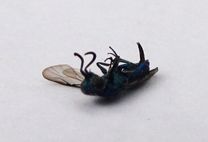Over the last few months, I have been writing about interesting insects that have crossed my path, even coming into the house. Now there has been another one.
I was sweeping dead flies off the windowsill, and noticed one that looked different. Under a hand lens, it showed up as a magnificent metallic blue something – not a fly (feelers wrong) – perhaps a bee?

No, nothing like it on the Internet under blue bees, maybe a wasp? Bingo, a Cuckoo Wasp, but as I could only get it down to family, I sent pictures again to the Discovery Centre at the museum, and they identified it as a Chrysis species.
According to the Atlas of Living Australia, there are less than twenty records of Chrysis species from Australia, – about six from Victoria and the rest from Queensland. This is the first for south-western Vic, but according to the Australian Museum, there are 76 species of Cuckoo Wasps, some in other genera.

These wasps are interesting. The Cuckoo Wasps are a group of 76 species that mostly parasitise other wasps. Like a cuckoo bird that manages to get another species to raise its chick, these wasps use another’s nest for their own young. Cuckoo Wasps can be seen hovering in gardens, where they feed on flower nectar and search for wasp nests. Their characteristic “scurry and fly” search pattern, when looking for hosts, is quite distinctive, even when seen from a distance. They land on a surface, typically either soil or wood, and scurry a short distance, in quick, hesitant spurts, with their antennae quivering vigorously as they go – and then they abruptly take off, typically only flying a short distance before landing again and repeating the manoeuvre. On finding the eggs, or the nest containing eggs of a suitable species, such as the Mud-dauber Wasp, the female Cuckoo Wasp lays an egg next to the egg of the host species. The Cuckoo Wasp’s egg hatches first, and the larva eats the food that is stored for the Mud-dauber’s young. The larvae of some Cuckoo Wasp species wait for the host larvae to hatch and have their meal, before attacking and eating them.

If the female Cuckoo Wasp is discovered invading the Mud-dauber’s nest, she rolls into a ball and uses special armour plates on her body to protect her. Because their hosts possess stings and biting mandibles, Cuckoo Wasps have evolved some defences, namely a thick integument (a tough, outer protective layer), and an ability to roll their body into a ball with their legs tucked in. These adaptations account for Cuckoo Wasps’ distinctive form: the thorax often having cavities for the reception of legs and the abdomen being flat or hollow on the underside and covered above with three convex plates. Female Cuckoo Wasps are widely believed to be unable to sting – the sting apparatus being reduced and supposedly non-functional – yet cases are known where people have received painful stings from larger species. A long, thin appendage may sometimes be seen extending from the tip of the female abdomen. This is not a ‘stinger’ but an ovipositor used for inserting eggs into the nest of a host. Observations of oviposition are few, but one author noted that a female of Stilbum cyanurum (another genus of wasp) wet the mud wall of a host nest, softening it, then inserted its ovipositor to deposit an egg.
Neil Tucker